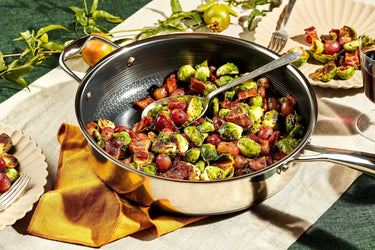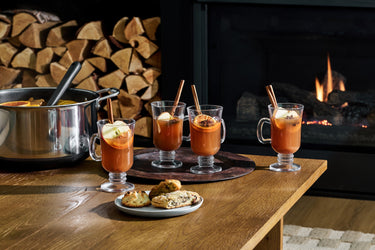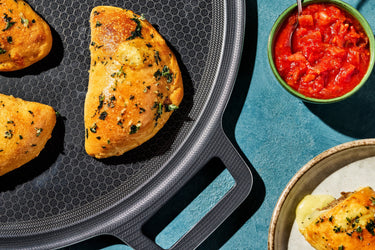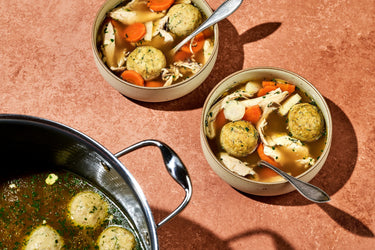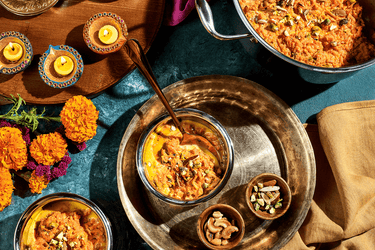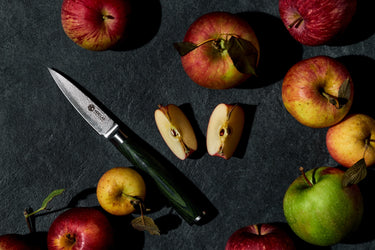Copper vs. Stainless Steel Cookware: The Pros & Cons
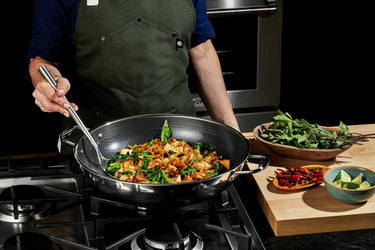
How we choose to cook can be a personal experience based on a foundation of personal taste, memory, and more. What we cook food in, however, seems to change with the weather.
There are somany cookware options on the market that promise to be the best choice for cooking. You see all these buzzwords about the different materials and why they’re the right option. It can make it tough to keep up and know the differences.
Today is all about copper and stainless steel cookware and what makes each both good and bad.
At the end of this read, you should have a lot more background knowledge on these two materials that will help you make the best choices for your kitchen.
How Cookware Has Changed Over the Years
Cooking food in pots and pans dates back to 400,000 years ago. Back then, early humans used turtle shells and hollowed-out tree bark to cook food.
In fact, archaeologists hypothesize that food ended up cooking on a fire virtually by accident. In the beginning, before civilization took off, fires were used by humans to ward off potential predators.
We’ve discovered animal bones in many unearthed ancient fireplaces, meaning that meat ended up on the fire at some point. Anything that burned would have been used as fuel for the fire, so the genesis of cooking on a fire may have been a happy accident.
However it happened, we now cook meat over the fire relatively infrequently, choosing alternative heat sources like the range and the oven, and saving the open flames for special events like BBQs and outdoor events. Either way, the flavor combinations that chefs have come up with throughout the years make our mouths water.
Cooking Utensils Today
So now we find ourselves here — cooking our meats to a perfect medium-rare (warm red center) and arguing over which type of material is the best option for cookware.
While the options may seem limitless, today is only about two metals: copper and stainless steel.
We’ve got the pros and cons of each, and the information here should put you on the right path for your culinary endeavors.
What Are the Pros of Copper Pans?
Copper is one of, if not the oldest, metals used for cooking purposes. It was mainly used as a decorative element in homes, featuring in art and other decor.
Thankfully, someone finally added it to a fire and put some food in it.
Copper Heats and Cools Quickly
The first pro to copper cookware we want to discuss is its ability to heat up. It heats up quickly and evenly, making for a quality cooking experience.
It also loses heat rapidly, which may seem like a con but is necessary when you’re cooking delicate items, like fish or a sauce like bearnaise.
When you add the final ingredients and pull the pan from the heat, copper will immediately cool down, which helps prevent these items from overcooking or breaking due to continual cooking after removing the heat source.
However, this can also be a con, depending on what you’re cooking. For example, many chefs turn their noses at copper cookware due to its inability to retain heat for long. Searing steaks and other meats can be an issue due to how fast copper cools down.
Copper Has AntiMicrobial Qualities
Copper is also well-known for its natural antimicrobial qualities. The National Library of Medicine conducted a study in third-world countries due to the recommendation of using copper pots to store drinking water. The results favored copper.
The study saw drinking water stored at room temperature for 16 hours. At the end of the study, scientists found no evidence of bacteria growing in the water stored in copper pots.
Copper is naturally resistant to microbes, so the same effect will benefit you at home. This gives a lot of chefs piece of mind when cooking food due to the diminished risk of bacteria surviving or thriving on their cookware.
Copper Looks Amazing
There’s no doubt about it. Copper pans on display in the kitchen make the space feel glamorous and cool. This style of cookware is a showstopper that never fails to impress.
Many cooking shows utilize copper pans for decoration due to the luxurious look they have on camera. Even if you only have one or two pans in your kitchen, they’re likely to draw attention when guests walk into your home.
What Are the Cons of Copper Pans?
While the benefits of copper seem great, there are still downsides to copper that you have to mull over.
They’re not total dealbreakers, but you should give them some thought before making any serious purchases.
Copper Is Expensive
Copper might look amazing in your kitchen, but it will cost you. It is one of the more expensive options for your kitchen. That might be why it’s so impressive if you have it.
A few key things factor into the high cost of this material.
For one, you have to factor in the sheer cost of raw copper. It costs more than steel or aluminum, so copper cookware companies consider this when pricing their pieces.
Copper pans are also generally hand-made, driving up the labor cost for each pan, which drives up the selling price.
Lastly, copper pans are heavier than other cookware materials. This can be both good and bad for chefs and home cooks. The pan's weight will factor into the selling and shipping costs.
A big selling point is that copper pans are usually sold separately rather than as a set. The pro to this con is that you can buy one or two pans as a splurge and use them once in a blue moon.
If you need a reference, consider copper like a fancy sports car. It’s incredible, flashy, and draws attention, but it probably isn’t your everyday pan.
Copper Is Reactive
Copper reacts with highly acidic foods, like lemon juice or anything tomato-based.
This means that the pan will alter your food when you’re cooking items with those acidic ingredients for long periods of time.
Cooking with copper may impact the color and taste of your food. This means that food will darken when it is supposed to be light. You may also notice a subtle but distinct metallic aftertaste with every bite.
The pH of these foods is too high for the molecular bonds of copper, and your food and family will suffer the consequences.
Copper Is High Maintenance
Copper cookware is high maintenance.
It cannot be put into the dishwasher and must be hand washed. This hand washing process must be done with care — you must wash it delicately, by hand, and then polish it every time you use it.
This can be a pro for some people. Maybe the benefit of cooking with such a delicate and gorgeous piece of cookware comes with the labor of love that goes into caring for it afterward.
For most chefs, however, this process is too much for everyday use. Daily use isn’t recommended for copper, even if you are careful before and after use.
Even if you can afford an entire set of copper pots and pans, you need to weigh the care and maintenance of the cookware against the cost and determine if it’s worth it in the end.
What Are the Pros of Stainless Steel?
Stainless steel has a lot of benefits, and we want to talk about all of them.
Consider a copper pan a novelty or specialty item to keep in your kitchen. Stainless steel, however, can be more of a workhorse.
Stainless Steel Is Easy To Care For
It is pretty simple to take care of a stainless steel pots and pans set. They’re dishwasher safe and can be used daily with ease. This makes them an excellent option for those just starting in the kitchen and who cook all the time.
Novice cooks, even seasoned ones, make mistakes in the kitchen. It happens to all of us from time to time. But with a stainless steel pan, you don’t have to worry that the burnt dinner you served your family will be sticking around.
You can use sturdy brushes on these pans to get rid of food residues without worrying about distrupting the quality or integrity of the pan.
Stainless Steel Models Can Have a 3-Ply Design
There are plenty of options on the market for stainless steel cookware. However, those like Hexclad pans, which feature a 3-ply design, are in a category all their own.
The design of a 3-ply pan is a layer of stainless steel, one of aluminum, and another layer of stainless steel.
This works exceptionally as the aluminum core will conduct heat evenly, making hot and cold spots on the pan a non-issue. The stainless steel exterior ensures that you have a strong pan, resistant to scratching and chipping.
The last big benefit to a bottom layer of stainless steel is its ability to react to various heat sources. You can even use these pots and pans on an induction stove, which requires a magnetic pan that can react with the cooking surface to begin the heating process.
Not all stainless steel is created equal, and this design reigns supreme.
Check out our technology page if you would like more information about the design and innovation process that sets our pots and pans apart.
Stainless Steel Heats Evenly
It may seem tedious, but preheating a stainless steel pan makes for a better cooking experience.
Why?
A stainless steel pan looks smooth, but tiny pores are on the surface. When you preheat the pan, the pores of stainless steel react to the heat, shrink, and close up any gaps in the surface that you can’t see. This creates a smooth surface that’s great even heating.
Turn the stove on medium heat and allow the pan to warm up for about two minutes. Then add cooking oil, let it settle for a moment, and add food.
This will give you an even cooking surface that won’t burn the food or cause it to stick to the pan. It may sound like an extra step, but you will be happy with the results in the end.
Stainless Steel Is Durable
Stainless steel is a durable option. This means it’s perfect for students away at school, new chefs just starting, and those that cook day in and day out.
Unlike copper cookware, you can use stainless steel for every meal, every day. And as we’ve said, you can use just about the strongest brush possible to clean it without issue.
Another great feature of the durability of stainless steel is its nonreactive quality. This means you can make those acidic tomato and lemon sauces without the risk of discoloration and metallic flavors in your food.
Stainless Steel Is Cost-Effective
Compared to copper, stainless steel is the more affordable option.
The quality will vary with the price, so there may be something to the price difference from one company to another. But as a whole, stainless steel can be purchased in a full set of cookware pots and pans for a more reasonable price compared to other materials, especially copper.
What Are the Cons of Stainless Steel?
We know: With so many pros, what could steer you away from stainless steel? There are a few potential cons you’ll want to consider.
The two biggest cons of stainless steel are also the easiest to avoid with a bit of information and care.
Stainless Steel Has a Risk of Leaching
Even though stainless steel is non-reactive, there are instances when the metal can leach certain flavors into your food.
Leaching is the term used to describe foods altered due to the metallic surface of your pots and pans. This alteration happens with prolonged use at one time, so be mindful of how long you let your sauces and foods simmer in your pans.
As expected, leaching becomes less of a concern as long as you buy high-quality products.
Stainless Steel Comes in Different Grades
You can diminish the risk of leaching when using stainless steel, however, by only buying the right kind of stainless steel.
Stainless steel pots and pans come in different grades: 200, 300, and 400. These grades are associated with the amount of nickel contained within the material. In addition to the design of stainless steel pans, not all stainless steel is created equal.
200 grade stainless steel contains less nickel than 300 grade and is more durable than 400 grade.
Grade 300 for stainless steel is most common for surgical equipment as it is the least corrosive and can withstand saline (saltwater) solutions.
Grade 400 is the cheapest option. It has more carbonand is less resistant to corrosion. It is also the least expensive, so be mindful of this when you’re selecting cookware.
You can save money with stainless steel versus copper, but don’t be cheap with stainless steel.
The Bottom Line
Both of these cookware materials offer benefits as well as some setbacks. Cooking at home with your family is an opportunity to make great food and memories you take into the future, so what you cook with needs to fit with your lifestyle.
The information here, and our personal recommendations, should come in handy, helping you make the most informed decision possible.
Sources:
Storing Drinking-Water in Copper Pots Kills Contaminating Diarrhoeagenic Bacteria | PMC
What’s a “Nonreactive Saucepan” and Why Does It Matter? | Edmonton Journal
